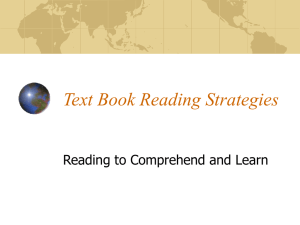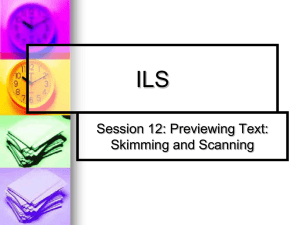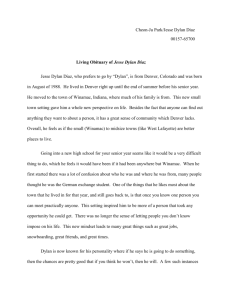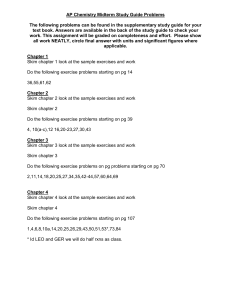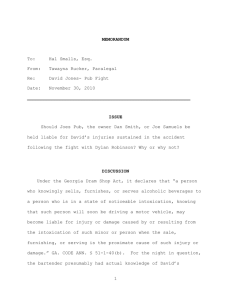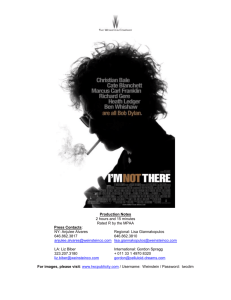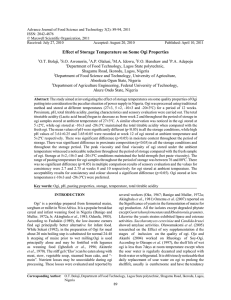Efficient Reading of Papers in Science and Technology
advertisement
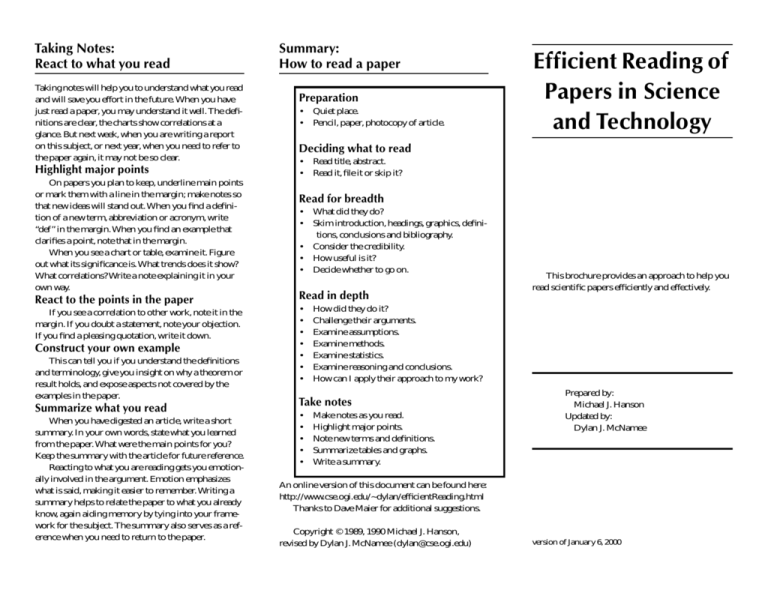
Taking Notes: React to what you read Taking notes will help you to understand what you read and will save you effort in the future. When you have just read a paper, you may understand it well. The definitions are clear, the charts show correlations at a glance. But next week, when you are writing a report on this subject, or next year, when you need to refer to the paper again, it may not be so clear. Highlight major points On papers you plan to keep, underline main points or mark them with a line in the margin; make notes so that new ideas will stand out. When you find a definition of a new term, abbreviation or acronym, write “def ” in the margin. When you find an example that clarifies a point, note that in the margin. When you see a chart or table, examine it. Figure out what its significance is. What trends does it show? What correlations? Write a note explaining it in your own way. React to the points in the paper If you see a correlation to other work, note it in the margin. If you doubt a statement, note your objection. If you find a pleasing quotation, write it down. Construct your own example This can tell you if you understand the definitions and terminology, give you insight on why a theorem or result holds, and expose aspects not covered by the examples in the paper. Summarize what you read When you have digested an article, write a short summary. In your own words, state what you learned from the paper. What were the main points for you? Keep the summary with the article for future reference. Reacting to what you are reading gets you emotionally involved in the argument. Emotion emphasizes what is said, making it easier to remember. Writing a summary helps to relate the paper to what you already know, again aiding memory by tying into your framework for the subject. The summary also serves as a reference when you need to return to the paper. Summary: How to read a paper Preparation • • Quiet place. Pencil, paper, photocopy of article. Efficient Reading of Papers in Science and Technology Deciding what to read • • Read title, abstract. Read it, file it or skip it? Read for breadth • • • • • What did they do? Skim introduction, headings, graphics, definitions, conclusions and bibliography. Consider the credibility. How useful is it? Decide whether to go on. Read in depth • • • • • • • How did they do it? Challenge their arguments. Examine assumptions. Examine methods. Examine statistics. Examine reasoning and conclusions. How can I apply their approach to my work? Take notes • • • • • This brochure provides an approach to help you read scientific papers efficiently and effectively. Make notes as you read. Highlight major points. Note new terms and definitions. Summarize tables and graphs. Write a summary. Prepared by: Michael J. Hanson Updated by: Dylan J. McNamee An online version of this document can be found here: http://www.cse.ogi.edu/~dylan/efficientReading.html Thanks to Dave Maier for additional suggestions. Copyright © 1989, 1990 Michael J. Hanson, revised by Dylan J. McNamee (dylan@cse.ogi.edu) version of January 6, 2000 Introduction: Why Read? Reading for Breadth: Build a framework Reading in Depth: Challenge what you read Before beginning to read a paper, consider why you are doing it. What do you want to get out of it? Your needs control how you read. If you only need an overview, a brief skim may suffice. If you will present the paper to others, you will need to dig deeply, to challenge the paper’s arguments until you understand it fully. If you will use the information later, taking notes will help you remember it. If you don’t know what you hope to gain from the paper, you can not tell whether reading it will be beneficial or a waste of time. In order to get the most from your reading, you should be properly prepared. Find a quiet place to work where you will not be disturbed or distracted, have a pencil and note pad at hand, and bear in mind exactly what you expect to get from this paper. The following method for reading a scientific paper offers you ideas about the process of reading a paper, how to decide what to read, how to build a broad framework by skimming, and how to challenge the paper to get depth of understanding. Finally, it will show you how to take notes so that the key points won’t be lost as soon as you set the paper down. Since reading is the process of getting ideas from the author, you must focus on the author’s thoughts, not just read the words on the paper. If you decide to read the paper, first skim it. • Read the introduction. • Read the section headings. • Look at the tables and graphs to see what they say and read the captions. • Read the definitions and theorems. • Read the conclusions. • Consider the credibility of the article: Who wrote it? Are they well-known? Where do they work? What biases might they have as a result of their employer? Where was the article published? What is the reputation of the journal? Was the journal refereed? When was it written? Might it be outdated or superceded? • Skim the bibliography: How extensive is it? Are the authors aware of current work? Does it reference classic papers in this field? Have you read any of the papers that are referred to? Do you know relevant research that isn't cited? There is a lot of junk published, so you should be selective in what you read and what you believe. When you read a paper in detail, approach it with scientific skepticism. You can do this by trying to tear the arguments apart. Deciding what to read When you first approach a paper, ask yourself “What did the author do?” Reading the title and the abstract should tell you this. Then decide if the paper is useful to you now. If so, read it. If not, might the paper be useful to you later? If so, file it. If it is not relevant to you, skip it. By skimming the paper first you can learn what the authors did, and develop a framework to understand the parts of the paper. Developing a framework adds to your general understanding of the field, and gives you a basis to understand the paper. If you know what conclusions they draw, you can follow their arguments more easily. Knowing where they are going can help you to follow their path and give you a chance to find shortcuts or places where they missed a turn. Once you have skimmed a paper you have a broad idea of what they did. Then you can decide if you want to know more. If you are interested in how they did it, then read the body of the paper for details. If not, file away what you have learned and congratulate yourself for saving the time of reading the paper in depth. Examine the assumptions • • Do their results rely on any assumptions about trends or environments? Are these assumptions reasonable? Examine the methods • • • • Did they measure what they claim? Can they explain what they observed? Did they have adequate controls? Were tests carried out in a standard way? Examine the statistics • • • Were appropriate statistical tests applied properly? Did they do proper error analysis? Are the results statistically significant? Examine the conclusions • • • Do the conclusions follow logically from the observations? What other explanations are there for the observed effects? What other conclusions or correlations are there in the data that they did not point out? By challenging what you read, you will understand better what the author is saying and why they say it. You will also be able to decide whether the evidence supports their conclusions, and to draw your own conclusions from their data. Once you understand the paper, ask yourself how you can apply their approach to your own work.
